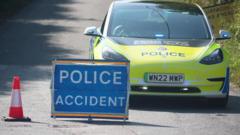What Happened When a Train Struck a Van at a Level Crossing?

Tragic Train-Van Collision in Kent: A Detailed Overview
A tragic incident involving a train and a van at a level crossing in Kent has resulted in the death of one individual. This unfortunate event has not only claimed a life but has also caused significant disruption to train services in the area. In this article, we will delve into the details surrounding the incident, the response from emergency services, and the ongoing investigation. We aim to provide comprehensive insights into the safety measures and implications of such accidents at level crossings.
Incident Summary
The collision occurred on a sunny afternoon at approximately 12:40 BST on Lower Road, Teynham. Kent Police, along with British Transport Police (BTP), were quickly dispatched to the scene following reports of the crash. Despite the swift arrival of paramedics and other emergency services, one person was pronounced dead at the scene, highlighting the severity of the accident.
The Scene of the Incident
The level crossing where the accident took place has been a point of concern for local residents and authorities alike. Level crossings are intersections where a railway line crosses a road at the same level, and they can pose significant risks if proper safety measures are not followed. In this particular case, the implications of the accident have caused severe disruption:
- Train services between Newington and Faversham were halted.
- A replacement bus service has been initiated to assist stranded passengers.
- Passengers on the train involved were transferred to another train and taken to Sittingbourne for onward travel.
Emergency Response and Investigation
The emergency response to the accident involved multiple agencies, including South East Coast Ambulance Service and Kent Fire & Rescue Service. Their prompt action underscored the urgency of the situation and the complexity of managing such incidents. The British Transport Police have confirmed that they are currently conducting an investigation into the circumstances surrounding the crash.
As the investigation unfolds, it will focus on several critical aspects:
- Understanding the sequence of events leading up to the collision.
- Examining the safety protocols in place at the level crossing.
- Assessing the condition of both the train and the van involved.
The Role of Train Services in Emergency Situations
In response to the incident, South Eastern Railway has emphasized its commitment to passenger safety and cooperation with the investigation. Their swift actions to transfer passengers to alternative transport options reflect a well-structured emergency response plan. However, this incident raises broader questions about the safety of rail crossings and whether existing measures effectively prevent accidents.
Understanding Level Crossings: Risks and Safety Measures
Level crossings are vital points of intersection for road vehicles and trains, designed to facilitate seamless transportation. However, they also present inherent risks. Understanding these risks is essential for both motorists and train operators alike.
Common Risks Associated with Level Crossings
While level crossings are equipped with safety features such as gates and signals, several factors can still lead to accidents:
- Driver Error: Distraction or a failure to heed warning signals can result in collisions.
- Mechanical Failure: Malfunctioning gates or signals may fail to alert drivers of an approaching train.
- Visibility Issues: Poor weather conditions or obstructions can impede clear sightlines for drivers.
Safety Measures in Place
To mitigate these risks, various safety measures are implemented at level crossings:
- Warning Signals: Lights and bells alert drivers when a train is approaching.
- Automatic Gates: These gates close when a train is nearing the crossing, preventing vehicles from entering.
- Education Campaigns: Ongoing initiatives aim to raise awareness about safe crossing practices among drivers.
The Impact of Train-Van Collisions on Communities
Tragic incidents like the one in Kent not only affect the immediate victims and their families but also have far-reaching effects on the community. The emotional toll, coupled with the disruption of local transport services, can create a ripple effect that impacts daily life.
Emotional and Psychological Effects
For families of victims, the aftermath of such accidents can be devastating. Grieving processes can be prolonged, and psychological support may be necessary. Communities often rally around those affected, providing emotional and logistical support during difficult times.
Economic and Social Implications
Beyond the emotional ramifications, accidents at level crossings can lead to economic consequences for local businesses and transport services. Disruption of train lines can impact commerce and daily commutes, leading to:
- Financial losses for local businesses reliant on foot traffic.
- Increased demand for alternative transportation methods, straining resources.
- Potential long-term impacts on property values in the vicinity of the crossing.
Future Safety Improvements and Community Involvement
In light of recent accidents, there is a growing call for enhanced safety measures at level crossings. Communities, local authorities, and transport agencies must work collaboratively to identify potential risks and implement solutions. This can include:
- Upgrading existing infrastructure with modern technology, such as sensors and cameras.
- Conducting regular safety audits to identify and rectify vulnerabilities.
- Engaging the public through awareness campaigns and educational programs.
The Importance of Community Awareness
Raising awareness about the dangers of level crossings is crucial. Community members should be informed about how to approach these crossings safely and the importance of obeying signals and warnings. Workshops and informational sessions can be effective tools in promoting safety.
Conclusion: Learning from Tragedy
The tragic accident in Kent serves as a somber reminder of the potential dangers associated with level crossings. As investigations continue, it is essential to reflect on how communities and authorities can work together to prevent future incidents. By enhancing safety measures, raising awareness, and fostering a culture of vigilance, we can strive to ensure that such tragedies do not occur again. The responsibility lies with all of us—drivers, rail operators, and community members—to prioritize safety and protect lives.
Frequently Asked Questions
What should I do if I encounter a level crossing?
Always approach level crossings with caution. Ensure that you obey all warning signals, look both ways for oncoming trains, and only proceed once the crossing is clear and safe.
How are level crossing safety measures enforced?
Safety measures are enforced through regular inspections by transport agencies, compliance checks with rail operators, and public safety campaigns to educate drivers about safe practices.
What are the legal consequences of ignoring level crossing signals?
Ignoring level crossing signals can lead to severe legal consequences, including fines, points on your driving license, and liability for accidents that occur as a result.
In light of recent events, how can communities better collaborate to improve safety at level crossings? #TrainSafety #CommunityAwareness #RoadSafety
Published: 2025-07-13 19:28:29 | Category: technology



